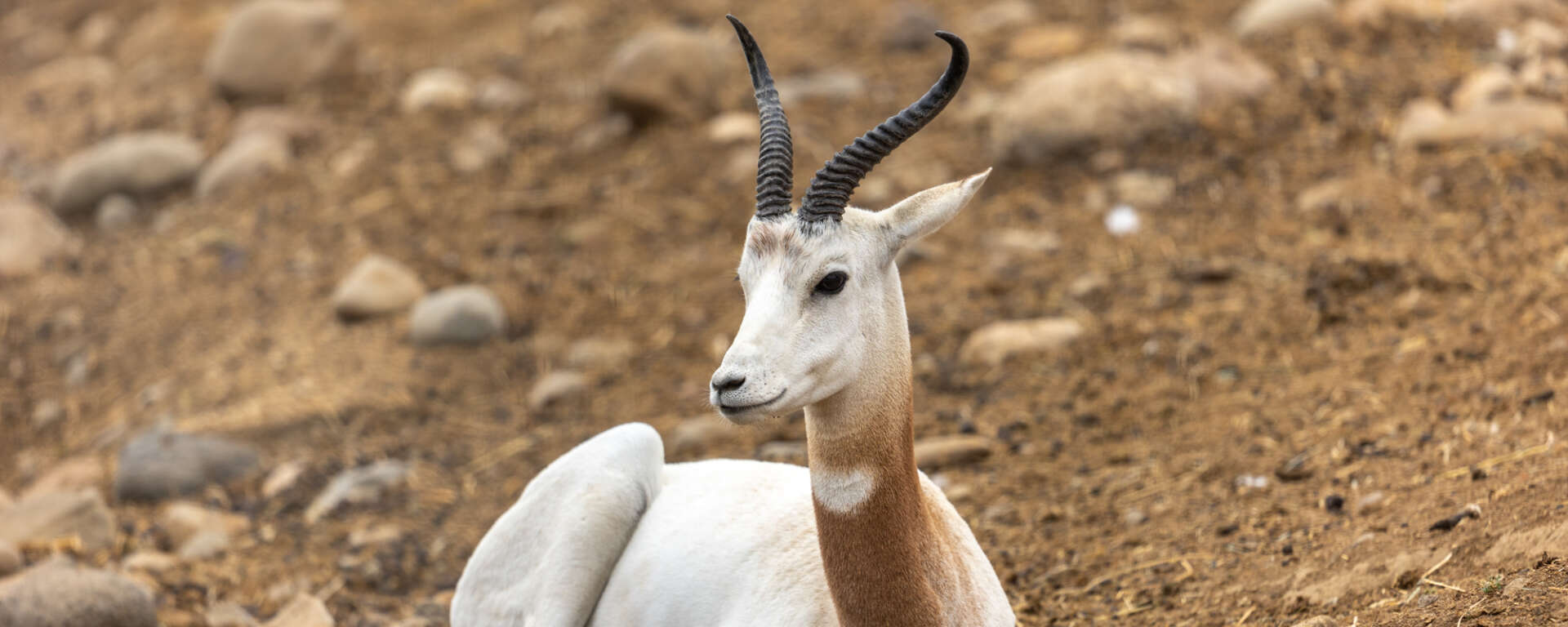Description
Like all gazelle, the dama maintain a slender, quick, and agile build. Both males and females grow horns which eventually curve backwards with a small point reaching up. The color displayed in the dama gazelle differs depending on the variety, or subspecies, being observed. Both varieties present degrees of patchy white and brown fur, however, the degree of one color dominance over the other is striking. The western variety (Nanger dama mohrr) will be almost completely reddish brown with patchy white fur, while the eastern variety (Nanger dama ruficollis) will be nearly all white the only brown found on its neck, face, and slightly across the back. Safari West currently has the eastern variety, N. d. ruficollis.
Cover Photo: Adult male dama gazelle by Mark Pressler
Classification
- Class
- Mammalia
- Order
- Cetartiodactyla
- Family
- Bovidae
- Genus
- Nanger
- Species
- N. dama
- Conservation Status
- Critically Endangered
Key Facts
- Height
- 3-4 ft (~90-120 cm)
- Weight
- 88-165 lb (~40-75 kg)
The IUCN Red List describes the dama gazelle as a Critically Endangered species. Populations have declined drastically since the 1950s and 1960s with a continued decreasing trend. The major threats to these animals include excessive hunting, habitat loss and degradation due to the over grazing of domestic livestock.
Social Life
The dama gazelle is a migratory desert species that moves through both the Sahara and Sahel deserts depending on the season. Their nomadic groups can range in size from 10 to 20 individuals on average and are typically headed by a single dominant male. To establish his dominance, this male will often stand apart from the group horning bushes or grasses and shaking his head to intimidate others.
Habitat and Range
Spending the wet season traversing the Sahara and the dry season in the Sahel, dama gazelle are sure to not stray too far from food. Despite the variability of these regions, the dama tend to avoid the mountains and dunes, preferring instead to stick to the flatter plains.
Diet
Relying on the sparse desert greens for both food and most of their water intake, these gazelle can be seen feeding on variety of plant life. Both a grazer and browser they will feed on desert shrubs, herbs, grasses, or even stand up on their hind legs to reach the leaves of the Acacia tree.
Lifespan
Typically lifespan in the wild and captivity are similar ranging anywhere from 12-20 years.
Predators
Most common predators include jackals, cheetahs, spotted hyenas, and lions. In some instances pythons have also been noted as a predator.
Reproduction
Sexual maturity: Male: 18-24 months, Female: 9-12 months
Mating Season: Spring to summer
Birth Season: Winter
Gestation: 6-6.5 months
No. of Young: 1
- Information
-
Description
Like all gazelle, the dama maintain a slender, quick, and agile build. Both males and females grow horns which eventually curve backwards with a small point reaching up. The color displayed in the dama gazelle differs depending on the variety, or subspecies, being observed. Both varieties present degrees of patchy white and brown fur, however, the degree of one color dominance over the other is striking. The western variety (Nanger dama mohrr) will be almost completely reddish brown with patchy white fur, while the eastern variety (Nanger dama ruficollis) will be nearly all white the only brown found on its neck, face, and slightly across the back. Safari West currently has the eastern variety, N. d. ruficollis.
Cover Photo: Adult male dama gazelle by Mark Pressler
Classification
- Class
- Mammalia
- Order
- Cetartiodactyla
- Family
- Bovidae
- Genus
- Nanger
- Species
- N. dama
- Conservation Status
- Critically Endangered
Key Facts
- Height
- 3-4 ft (~90-120 cm)
- Weight
- 88-165 lb (~40-75 kg)
- Conservation
The IUCN Red List describes the dama gazelle as a Critically Endangered species. Populations have declined drastically since the 1950s and 1960s with a continued decreasing trend. The major threats to these animals include excessive hunting, habitat loss and degradation due to the over grazing of domestic livestock.
- Lifestyle
Social Life
The dama gazelle is a migratory desert species that moves through both the Sahara and Sahel deserts depending on the season. Their nomadic groups can range in size from 10 to 20 individuals on average and are typically headed by a single dominant male. To establish his dominance, this male will often stand apart from the group horning bushes or grasses and shaking his head to intimidate others.Habitat and Range
Spending the wet season traversing the Sahara and the dry season in the Sahel, dama gazelle are sure to not stray too far from food. Despite the variability of these regions, the dama tend to avoid the mountains and dunes, preferring instead to stick to the flatter plains.Diet
Relying on the sparse desert greens for both food and most of their water intake, these gazelle can be seen feeding on variety of plant life. Both a grazer and browser they will feed on desert shrubs, herbs, grasses, or even stand up on their hind legs to reach the leaves of the Acacia tree.Lifespan
Typically lifespan in the wild and captivity are similar ranging anywhere from 12-20 years.Predators
Most common predators include jackals, cheetahs, spotted hyenas, and lions. In some instances pythons have also been noted as a predator.Reproduction
Sexual maturity: Male: 18-24 months, Female: 9-12 months
Mating Season: Spring to summer
Birth Season: Winter
Gestation: 6-6.5 months
No. of Young: 1

